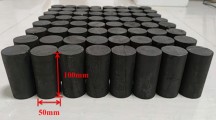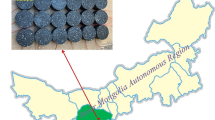Abstract
The generalization and application of fully mechanized caving with super great mining height (SGMH) face a series of new issues, of which strata pressure behavior and abnormal gas emissions are the most prominent disasters and display a close relationship. The Tashan coalmine was chosen as the experiment base because of its SGMH and the overlying hard and thick main roof (HTMR). This coalmine had experienced many damaging hydraulic support and abnormal gas emission accidents induced by strata pressure behavior. The “Key Strata Theory” and the fracture failure process analysis model established by 3DEC were used to analyze the structural characteristics and fracture failure process of the HTMR. The geostress reduction and permeability enhancement redistribution of the adjacent coal measure strata were studied by the geostress and permeability distribution model established by FLAC 3D. The HTMR controlled the failure extent and the movement evolution of the entire overburden stratum. The HTMR acted as a large double-sided embedded rock beam during primary fracturing and a cantilever-articulated rock beam during periodic fracturing, and it generated a huge hanging space above the gob. The fully mechanized caving with SGMH caused large-scale disturbances and permeability enhancements in the adjacent rock and coal strata. Then, the substantial amounts of gas stored in the remaining coal, surrounding rock strata and adjacent coal seam rushed out and aggregated in the caved and fissured zones of the gob, forming a huge gas warehouse. The strata pressure behavior and abnormal gas emission disasters primarily occurred after the primary and periodic fracturing of the HTMR. These disasters are predominantly caused by the escaping of the abundant gas that existed in the gob during mine pressure behavior processes. When the ultimate broken span was reached, as the HTMR rotated and collapsed, the substantial amounts of gas that accumulated in the gob escaped into the working face, which easily caused abnormal gas emissions. Hydraulic presplitting and gas drainage technologies are proposed to solve these disasters.


















Similar content being viewed by others
References
Airey EM (1968) Gas emission from broken coal. An experimental and theoretical investigation. Int J Rock Mech Min Sci 5(6):475–494
Anep C (1959) Rockburst. Zhu Min et al. trans. Beijing: China Coal Industry Publishing House
AQ 1080-2009a (2009) Determination Method for Index (ΔP) of initial velocity of diffusion of coal gas. State Administration of Work Safety of China
AQ 1018-2006 (2006) The predicted method of mine gas emission rate. State Administration of Work Safety of China, China
ASTM (2007) Annual Book of ASTM Standards. Section Five, Petroleum Products. Lubricants, and Fossil Fuels, vol 05.06. ASTM International, West Conshohocken. pp 711
Boxho J, Gemeinschaften DKE (1980) Firedamp drainage: handbook for the coalmining industry in the European Community. Verlag Glückauf, Essen 415
Bräuner G (1981) Gebirgsdruck und Gebirgsschläge. Verlag Gluckauf GmbH, Essen
Bustin RM (1997) Importance of fabric and composition on the stress sensitivity of permeability in some coals, northern Sydney basin, Australia: relevance to coalbed methane exploration. AAPG Bull 81(11):1894–1908
Cai JD, Li ZJ, Li HM (2009) Relationship between periodic roof weighting and gas emission from stopping area. Min Metal Eng 29(2):12–15 (in Chinese)
Cao AY, Zhu LL, Li FC, Dou LM, Zhao YL, Zhang ZL (2014) Characteristics of T-type overburden structure and tremor activity in isolated face mining under thick-hard strata. J China Coal Soc 39(2):328–335 (in Chinese)
Coggan J, Gao FQ, Stead D, Elmo D (2012) Numerical modelling of the effects of weak immediate roof lithology on coal mine roadway stability. Int J Coal Geol 90–91:100–109
Cui XJ, Bustin RM (2005) Volumetric strain associated with methane desorption and its impact on coalbed gas production from deep coal seams. Aapg Bull 89:1181–1202
Diamond WP, Ulery JP, Kravits SJ (1992) Determining the source of longwall gob gas: lower kittanning Coalbed, Cambria County, PA. US Department of the Interior, Bureau of Mines, Information Circular No: 9430
Durucan S, Edwards JS (1986) The effects of stress and fracturing on permeability of coal. Min Sci Technol 3(3):205–216
GB/T 23250-2009 (2009) The direct method of determining coalbed gas content in the mine. State Bureau of Quality Technology Supervision of the People’s Republic of China
GB/T 23561.12-2010 (2010) Methods for determining the physical and mechanical properties of coal and rock—part 12: methods for determining coal hardiness coefficient. State Bureau of Quality Technology Supervision of China
Gray I (1987) Reservoir engineering in coal seams: part 1. The physical process of gas storage and movement in coal seams. SPE Res Eng 2(01):28–34
Harpalani S, Chen GL (1995) Estimation of changes in fracture porosity of coal with gas emission. Fuel 74(10):1491–1498
International Standards Organization 7404-5 1994-E (1994) Methods for the petrographic analysis of bituminous coal and anthracite: part 5. Method of determining microscopically the reflectance of vitrinite, 2nd edn. International Standard, Geneva, pp 1–13
Itasca (2013) 3DEC-3-dimensional distinct element code. version 4.10. Itasca Consulting Group, Minneapolis
Jiang JY, Cheng YP, Wang L, Li W, Wang L (2011) Petrographic and geochemical effects of sill intrusions on coal and their implications for gas outbursts in the Wolonghu Mine, Huaibei Coalfield, China. Int J Coal Geol 88(1):55–66
Ju JF, Xu JL (2013) Structural characteristics of key strata and strata behaviour of a fully mechanized longwall face with 7.0 m height chocks. Int J Rock Mech Min Sci 58:46–54
Karacan CÖ, Esterhuizen GS, Schatzel SJ, Diamond WP (2007) Reservoir simulation-based modeling for characterizing longwall methane emissions and gob gas venthole production. Int J Coal Geol 71:225–245
Li SG (1998) Gas delivery feature and its control influenced by movement of the surrounding rock in fully-mechanized top coal caving. PhD thesis, China University of Mining & Technology, Xuzhou (in Chinese)
Li T, Cai MF, Cai M (2007) Earthquake-induced unusual gas emission in coalmines-A km-scale in situ experimental investigation at Laohutai mine. Int J Coal Geol 71:209–224
Li HM, Wang W, Xiong ZD (2008) Relationship between mining induced surrounding rock movement and gas emission in working face. J Min Safety Eng 25(1):11–16 (in Chinese)
Lu CP, Dou LM, Zhang N, Xue JH, Wang XN, Liu H, Zhang JW (2013) Microseismic frequency-spectrum evolutionary rule of rockburst triggered by roof fall. Int J Rock Mech Min Sci 64:6–16
Lunarzewski LLW (1998) Gas emission prediction and recovery in underground coal mines. Int J Coal Geol 35:117–145
Ma QA, Harpalani S, Liu SM (2011) A simplified permeability model for coalbed methane reservoirs based on matchstick strain and constant volume theory. Int J Coal Geol 85(1):43–48
McKee CR, Bumb AC, Koenig RA (1988) Stressdependent permeability and porosity of coal and other geologic formations. SPE Form Eval 3(01):81–91
Mohammad N, Reddish DJ, Stace LR (1997) The relation between in situ and laboratory rock properties used in numerical modelling. Int J Rock Mech Min Sci 34:289–297
Mucho TP, Diamond WP, Garcia F, Byars JD (2000) Implications of recent NIOSH tracer gas studies on bleeder and gob gas ventilation design. In: Proceedings of Annual Meeting of Society for Mining, Metallurgy and Exploration, Salt Lake City
Noack K (1998) Control of gas emissions in underground coal mines. Int J Coal Geol 35:57–82
Pini R, Ottiger S, Burlini L, Storti G, Mazzotti M (2009) Role of adsorption and swelling on the dynamics of gas injection in coal. J Geophys Res: Solid Earth 114(B04203):1–14
Qian MG, Miao XX, Xu JL, Mao XB (2003) Study of key strata theory in ground control. China University of Mining and Technology Press, Xuzhou (in Chinese)
Qian MG, Shi P, Xu JL (2010) Ground pressure and strata control. China University of Mining and Technology Press, Xuzhou (in Chinese)
Radlinski AP, Mastalerz M, Hinde AL, Hainbuchner M, Rauch H, Baron M, Lin JS, Fan L, Thiyagarajan P (2004) Application of SAXS and SANS in evaluation of porosity, pore size distribution and surface area of coal. Int J Coal Geol 59(3–4):245–271
Seidle JP, Jeansonne MW, Erickson DJ (1992) Application of matchstick geometry to stress dependent permeability in coals. SPE 24361:18–21
Somerton WH, Söylemezoḡlu IM, Dudley RC (1975) Effects of stress on permeability of coal. Int J Rock Mech Min Sci Geo Abs tracts 12(5):129–145
Tang CA, Kaiser PK (1998) Numerical simulation of cumulative damage and seismic energy release during brittle rock failure—part I: fundamentals. Int J Rock Mech Min Sci 35:113–121
Unver B, Yasitli NE (2006) Modelling of strata movement with a special reference to caving mechanism in thick seam coal mining. Int J Coal Geol 66:227–252
Wang YW, Jiang WZ, Niu DW (2002) The experimental research on rockmass friction detonating gas. Saf Coal Min 33:8–10 (in Chinese)
Wang XJ, Qian XS, Ma LQ, Zhang W (2009) Research on large mining height technique for thick coal seams. J Min Safety Eng 26(2):212–216 (in Chinese)
Wang T, Wang ZH, Liu HB, Guan YP, Zhan SJ (2014) Discussion about the mechanism of gas disaster induced by coal bump. J China Coal Soc 39(2):371–376 (in Chinese)
Weng MY, Xu JH, Li C (2011) Relationship of coal and rock damage, underground behavior and methane gushing in fully-mechanized caving mining face. J China Coal Soc 36(10):1709–1715 (in Chinese)
Xie HP, Zhou HW (2008) Application of fractal theory to top-coal caving. Chaos Soliton Fract 36:797–807
Xu ZQ (2001) Study of several problems concerning selection of physical and mechanical parameters of rock used for numerical analysis. MS thesis, J Univ Sci Technol B 16–17 (in Chinese)
Yang TH, Xu T, Liu HY, Tang CA, Shi BM, Yu QX (2011a) Stress–damage–flow coupling model and its application to pressure relief coal bed methane in deep coal seam. Int J Coal Geol 86:357–366
Yang W, Lin BQ, Qu YA, Zhao S, Zhao C, Jia LL, Zhao WQ (2011b) Mechanism of strata deformation under protective seam and its application for relieved methane control. Int J Coal Geol 85:300–306
Yasitli NE, Unver B (2005) 3D numerical modeling of longwall mining with top-coal caving. Int J Rock Mech Min Sci 42:219–235
Yavuz H (2004) An estimation method for cover pressure re-establishment distance and pressure distribution in the goaf of longwall coal mines. Int J Rock Mech Min Sci 41:193–205
Yu B, Yu Q (2005) Coal gas disaster control and utilization technological manual. China Coal Industry Publishing House, Beijing (in Chinese)
Yu W, Miao XX, Mao XB, Xu JL (2005) Analysis of the heating-up mechanism in the course of the rock ram. Chin J Rock Mech Eng 24:1535–1538 (in Chinese)
Zhou XQ, Zhou BX, Zhu HQ (2004) Study on ignition temperature characteristic of frictional spark inducing gas. J Hunan Univ Sci Technol 19(1):1–4 (in Chinese)
Zimmerman RW, Somerton WH, King MS (1986) Compressibility of porous rocks. J Geophys Res: Solid Earth 91(B12):765–777
Acknowledgments
The work presented in this paper was financially jointly supported from the National Basic Research Program of China (973 Program, No. 2011CB201204), the General Project of the National Natural Science Foundation of China (Grant No. 51374204), the Fundamental Research Funds for the Central Universities (No. 2013RC05), the Program for New Century Excellent Talents in University (NCET-11-0727), and the China Postdoctoral Science Foundation (No. 2014T70561). Besides, the authors would like to thank the editor and the reviewers for their meticulous examinations, valuable comments, and constructive suggestions on the manuscript.
Author information
Authors and Affiliations
Corresponding author
Rights and permissions
About this article
Cite this article
Wang, W., Cheng, Yp., Wang, Hf. et al. Coupled disaster-causing mechanisms of strata pressure behavior and abnormal gas emissions in underground coal extraction. Environ Earth Sci 74, 6717–6735 (2015). https://doi.org/10.1007/s12665-015-4682-2
Received:
Accepted:
Published:
Issue Date:
DOI: https://doi.org/10.1007/s12665-015-4682-2




